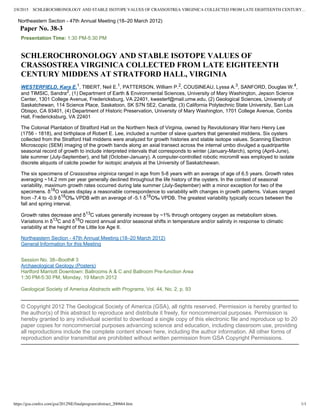More Related Content Similar to Schlerochronology and Stable Isotope Values of Crassostrea Virginica Collected from Late Eighteenth Century Middens at Stratford Hall, Virginia Similar to Schlerochronology and Stable Isotope Values of Crassostrea Virginica Collected from Late Eighteenth Century Middens at Stratford Hall, Virginia (6) 1. 2/8/2015 SCHLEROCHRONOLOGY AND STABLE ISOTOPE VALUES OF CRASSOSTREA VIRGINICA COLLECTED FROM LATE EIGHTEENTH CENTURY…
https://gsa.confex.com/gsa/2012NE/finalprogram/abstract_200664.htm 1/1
Northeastern Section 47th Annual Meeting (18–20 March 2012)
Paper No. 383
Presentation Time: 1:30 PM5:30 PM
SCHLEROCHRONOLOGY AND STABLE ISOTOPE VALUES OF
CRASSOSTREA VIRGINICA COLLECTED FROM LATE EIGHTEENTH
CENTURY MIDDENS AT STRATFORD HALL, VIRGINIA
WESTERFIELD, Kara E.1, TIBERT, Neil E.1, PATTERSON, William P.2, COUSINEAU, Lyssa A.3, SANFORD, Douglas W.4,
and TIMSIC, Sandra2, (1) Department of Earth & Environmental Sciences, University of Mary Washington, Jepson Science
Center, 1301 College Avenue, Fredericksburg, VA 22401, kwesterf@mail.umw.edu, (2) Geological Sciences, University of
Saskatchewan, 114 Science Place, Saskatoon, SK S7N 5E2, Canada, (3) California Polytechnic State University, San Luis
Obispo, CA 93401, (4) Department of Historic Preservation, University of Mary Washington, 1701 College Avenue, Combs
Hall, Fredericksburg, VA 22401
The Colonial Plantation of Stratford Hall on the Northern Neck of Virginia, owned by Revolutionary War hero Henry Lee
(1756 1818), and birthplace of Robert E. Lee, included a number of slave quarters that generated middens. Six oysters
collected from the Stratford Hall middens were analyzed for growth histories and stable isotope values. Scanning Electron
Microscopic (SEM) imaging of the growth bands along an axial transect across the internal umbo divulged a quadripartite
seasonal record of growth to include interpreted intervals that corresponds to winter (JanuaryMarch), spring (AprilJune),
late summer (JulySeptember), and fall (OctoberJanuary). A computercontrolled robotic micromill was employed to isolate
discrete aliquots of calcite powder for isotopic analysis at the University of Saskatchewan.
The six specimens of Crassostrea virginica ranged in age from 58 years with an average of age of 6.5 years. Growth rates
averaging ~14.2 mm per year generally declined throughout the life history of the oysters. In the context of seasonal
variability, maximum growth rates occurred during late summer (JulySeptember) with a minor exception for two of the
specimens. δ18O values display a reasonable correspondence to variability with changes in growth patterns. Values ranged
from 7.4 to 0.9 δ18O‰ VPDB with an average of 5.1 δ18O‰ VPDB. The greatest variability typically occurs between the
fall and spring interval.
Growth rates decrease and δ13C values generally increase by ~1% through ontogeny oxygen as metabolism slows.
Variations in δ13C and δ18O record annual and/or seasonal shifts in temperature and/or salinity in response to climatic
variability at the height of the Little Ice Age II.
Northeastern Section 47th Annual Meeting (18–20 March 2012)
General Information for this Meeting
Session No. 38Booth# 3
Archaeological Geology (Posters)
Hartford Marriott Downtown: Ballrooms A & C and Ballroom Prefunction Area
1:30 PM5:30 PM, Monday, 19 March 2012
Geological Society of America Abstracts with Programs, Vol. 44, No. 2, p. 93
© Copyright 2012 The Geological Society of America (GSA), all rights reserved. Permission is hereby granted to
the author(s) of this abstract to reproduce and distribute it freely, for noncommercial purposes. Permission is
hereby granted to any individual scientist to download a single copy of this electronic file and reproduce up to 20
paper copies for noncommercial purposes advancing science and education, including classroom use, providing
all reproductions include the complete content shown here, including the author information. All other forms of
reproduction and/or transmittal are prohibited without written permission from GSA Copyright Permissions.

